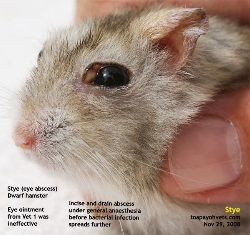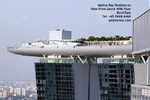|
|
| |
Toilet-training issues in
Singapore puppies
Dr Sing Kong Yuen, BVMS (Glasgow), MRCVS
Case 1 was recorded in Jan 2007.
Update:
21 September, 2010 |
 toapayohvets.com toapayohvets.com
Be Kind To Pets
Veterinary Education
Project 2010-0129 |
Case 1:
A professional dog breeder
shares his 30 years of experiences
"There is no money to be made in writing a puppy book,"
the experienced Chihuahua breeder with over 30 years of
dog breeding visited me when I phoned him for a meeting
to get his advices on puppy upbringing in an apartment.
He is 73 years old and in excellent health and is still
hands-on in breeding.
"You are correct," I knew this to be a fact of life.
"99% of Singapore authors can't earn a living writing.
But we are growing old. We are in good health. We should
pass some of our experiences with dogs to the younger
generation through writing. The internet provides bits
and pieces of information. If I can record down all the
essential information in a useful puppy toilet training
book, it will be very good for the puppies as the
educated owner will take better care of them and a
toilet-trained dog can get a new home if things don't
work out for them."The Chihuahua
breeder sat down and shared the following advices:
0-4 weeks. Puppy drinking milk from the mother.
Eyes open at 10-14 days. Mum cleans up the pups.
5 weeks. Puppy starts learning to walk and to
taste mother's dog food. Mum growls as she dislikes
sharing.
6-7 weeks. Mum avoids or bites the puppies. The
puppy teeth are sharp and hurts mum's nipples during
suckling. Pups are separated and weaned on dry puppy
food + water + egg or other supplements.
6-8 weeks. Puppies sleep a lot. Play-fighting.
Sleeps. Nails must be trimmed to prevent eye injury in
Chihuahuas. Feeding is 3 times per day. 6 am, 1
pm, 7 pm. Exercise by taking out of the crate and pee
pan is 1x/day. Puppies play in the playpen. When lights
are switched off at night, puppies go to sleep. No night
barking from his puppies. (The breeder lives in a quiet
apartment area).
8-12 weeks. Puppies sleep less and wakes up when
people are around. Play-fighting can be rough. A healthy
puppy is a very greedy puppy. Slow eaters are fed
separately. Dry puppy feed is left for 2 hours and then
thrown away. Feeding is 3x/week. Puppies will poop
immediately after eating.
Puppy Laws of Singapore. Puppies are sold at this
age. "As you are aware, the Agri-Food and Veterinary
Authority (AVA) directs that puppies can only be sold or
imported at 3 months of age and with 2 vaccinations in
Singapore," the breeder said to me. "Yes," I replied.
"Many puppies die when they are sold at 8 weeks as
owners don't know how to take good care of them or they
have been infected with parvoviruses."
0-6 months. The breeder defines this as the "baby
puppy stage".
6-12 months. The breeder defines this as the "big
puppy stage". At 12th month, adult dry dog food is
fed to small breeds like the Chihuahua.
Housing. Crate + Pee Pan. Newspapers with stools
and urine in the pee pan are replaced when soiled.
Washing of the crate + pee pan is two times per week.
His puppies are thus not "paper-trained."
Vaccination. 6th week, 8th week and sold to
the pet shop said to be 2 weeks after the 2nd
vaccination, according to the AVA directives. The pet
shop or vet usually advises a 3rd vaccination.
Kennel cough and parvoviral infections. He does
not have these health problems in his breeding in the
apartment unlike large-scale production in breeding
farms. Diarrhoea occur sometimes in the puppies.
Night barking in puppies. No problem. They sleep
throughout the night when lights are switched off.
Feeding. Premium dry puppy food + egg supplements
for puppies. Water must be available 24 hours. "How do
you measure the amounts to be fed?" I asked. "Just
observe that the stomach is full. If the puppy does not
finish his 7 pm feed, he is sick" the breeder said. At
the pet shop where puppies are sold, puppies are usually
fed 2 times/day. Buyers are advised similarly for
most breeds and there is no problem with the routine.
Puppy books often advise 3-4 times per day for puppies
8-12 weeks old.
NOTE: Chihuahuas, mini-Maltese, Yorkshire
Terriers and very small breeds need to be fed 3 times
per day as they may not eat much and get hypoglycaemia
(low blood glucose) and die easily.
Sleeping. Puppies up to 12 weeks old sleep a lot.
Bathing. Towel is used to clean up the puppies
less than 8 weeks old. Wash the back if there is
diarrhoea.
CONCLUSION. Many Singapore puppy owners have
difficulty in paper-training their puppies. This is
because puppies are mainly reared in the crate + pee pan
housing. They contact the grate as flooring, not
newspapers.
Therefore, such owners are doomed to failure if they
expect the puppies to convert to paper-training within 3
days. In puppies reared on paper by the home-breeder,
many puppies just go to the papers on Day 1 after
purchase, delighting the owner. The puppy toilet
training book is still a work in progress.
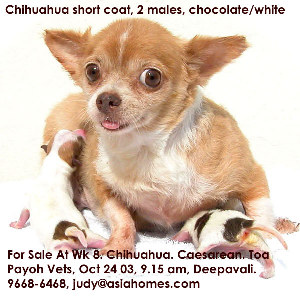 |
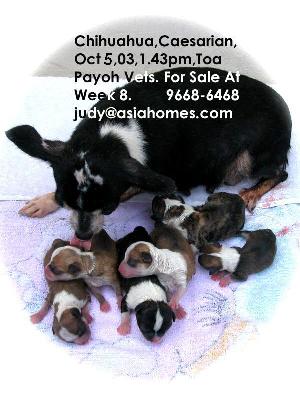 |
My favourite
picture.
The Chihuahua dam will not hesitate to bite me to
protect her puppies if I get closer. One of the
breeders I worked with in Pasir Ris area
|
My 2nd
favourite Chihuahua picture. Pups were from the
breeder who offered his advices to me in this
report (Case 1). There is a pattern of the puppies
seeking warmth from mum to suckle milk |
|
Case 2:
The ex-dog breeder shares his experiences
First written: Sep 14, 2007
He saw the opportunity in the new microchip law
effective from Sep 1, 2007. All Singapore dogs must
be microchipped before they can obtain their licence.
Otherwise a fine of $5,000 for not possessing a dog
licence. Apparently all dogs 3 months and above.
Spayed and neutered males are charged around $14.00.
Intact ones pay around $75.00.
Now, the dilemma of the Singapore puppy owners is
that they can't get the cheaper rate of $14.00
because the puppy is too young to be sterilised at 3
months of age. Maybe they can't find a vet who is
willing to do it. So there must be some grumbles at
the need to pay $75.00 in this case.
From what I hear from a pet shop operator, they now
pay $14.00 from month 3 - 6, get the dog sterilised
and extend the "validity" of the licence. Failing to
sterilise means that they have to pay $75 at month
6. I don't know whether this is a new policy?
In any case, one ex-dog breeder sourced his
microchips and got them approved by the regulatory
authorities with letter of proof to show me. He
dropped his price lower than his competitors. He
went to all pet shops, vets and every relevant
prospect.
I had a microchip scanner which could not read. I
rushed out to NTUC Toa Payoh and bought a battery.
The scanner could not work. The message said
"powering down" after one successful scan.
I asked my man to look into it. He sent it to Funan
computer centre and was told that the scanner needed
to be sent to the U.S as there is no spare part.
The ex-dog breeder was willing to help. He took out
his "Made in USA Energiser battery", 9V from his
scanner which he also sells. His diagnosis was spot
on. There was nothing wrong with the scanner!
"You bought a rechargeable battery," the ex-dog
breeder patiently explained. Maybe it was not
charged. Buy a 'Made in the U.S' battery similar to
mine." A very helpful salesperson. He built a lot of
goodwill and it was quite embarrassing.
He was a breeder of 50 dogs 8 years ago but his
advices still remain relevant today. These are:
1. Hygiene is paramount. Weekly disinfection of the
crates and the floors below because parvovirus are
"air borne" in big breeding areas.
2. Crated dogs above ground level. So, easier to
disinfect flooring below.
3. Vaccination must be done regularly. Many breeders
forget after a while. So more viruses come in.
4. Good quality breeds. No point breeding Jack
Russells. Maltese and Shih Tzus of good quality are
in demand.
5. 24-hour or very close monitoring of breeding dams
58-60 days. Be available to help the dam not able to
give birth. Every puppy lost is money down the
drain.
6. "How do you control ticks?" I asked.
Use a brand (name given). Not toxic to dogs and
puppies (that what the brand label stated). Wash dog
frequently. So tick population reduced. So, less
ticks.
7. Crates above floor level is one way to reduce
tick population but regular check up is necessary.
|
Case 3:
E-mail advices on toilet-training
Thanks for the beautiful photos.
I have thought over the reasons why Cookie still
poops in the study or kitchen despite being spanked
after reviewing the over 500 cases of toilet
training reports from other puppy owners in
Singapore in the past 3 years.
The most likely reasons Cookie looks for the study
room or kitchen to poop are:
1. Many puppies poop within 10 minutes after eating
if undistracted after eating.
But Cookie poops 30 - 60 minutes after eating. This
is because he is distracted by the 8-year-old
daughter's presence after breakfast and will not
poop soon after eating. As you said, she takes the
puppy out of the playpen assuming he has had pooped
in the morning. Actually he has had pooped
overnight.
2. After 30 - 60 minutes out of the playpen, Cookie
needs to poop. NO way he is going into the playpen
to do it although you have had changed to fresh
papers. In any case, the playpen has no door for him
to get to the fresh newspapers you had put in.
You will be busy preparing breakfast for the husband
and children. So, Cookie dashes to his favourite
corner in the study room (if the door is left open)
or to the kitchen floor to poop.
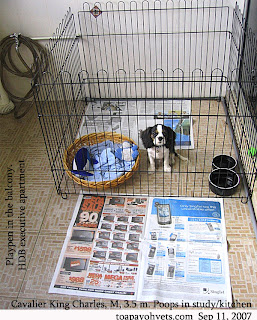 Solutions: Solutions:
1. Some owners open up the playpen in the morning by
taking out one fencing, so that the puppy has access
to the fresh newspapers (the first toilet location).
2. Other owners have playpens with a door opened so
that the puppy goes in for pooping and peeing. Your
playpen does not have this configuration. So there
is no immediate access to the toilet location during
the last 6 weeks. The puppy resorts to finding a
second toilet location---the study or kitchen for
pooping and outside the playpen for peeing.
In your case, it may be possible to remove the
playpen fencing by storing away the fences. Close
the sliding door of the balcony and make sure that
Cookie poops and pee on the fresh newspapers before
he is allowed out. When he gets rewarded by food
treats for doing it, you can open the sliding door.
3. He pees outside his playpen. The reason is that
Cookie cannot control his bladder well at 4 months
of age. According to a guideline, using a formula
N-1, where N=puppy's age in months, Cookie pees
every 3 hourly. So he pees outside the playpen as he
is not crated during the day.
I note you have put a second piece of newspapers
outside the playpen in the picture.
Conclusion.
With children and a husband and possibly neighbours
and in-laws visiting and interacting with the puppy,
there are so many distractions affecting the success
of paper-training of a new puppy in an apartment.
Cookie's natural instincts is a very clean puppy and
this is what he tries to communicate to you. Now he
has been 6 weeks into toilet training. In general
the success in paper training in most Singapore's
dog owners are around 4-8 weeks. Couples without
children or distracting friends and in-laws are
successful in around 2 weeks.
After writing so much, what is the solution? More
spanking? I can only propose the following:
1. Take away the playpen fencing during the day.
Increase the newspaper coverage of the balcony
floor.
You have been correct to reduce the 100% coverage of
the playpen floor during week 1 after purchase so
that the puppy eliminates on the newspapers. You
then reduce the newspapers to a corner of the
playpen. You change soiled newspapers regularly
(every hour?). In this way, you have been successful
in paper-training.
2. Close the sliding door in the morning so that
Cookie poops on the newspapers after breakfast
before coming out to play. Give your food treat and
praise once he has pooped and let him out.
3. Access to a second toilet area but no access to
the whole apartment in week 2 and 3 after purchase.
This was not possible or done in your case. For
example, barricade the balcony and gradually let the
puppy have access to more room, e.g. living and
dining area. The second toilet area will have
newspapers with Cookie's urine smell. This could be
in the living area on week 2 and 3 after purchase.
Now it is week 6 after purchase. Close the study room
door at all times. Put newspapers in the favourite
spot in the kitchen. Neutralise the urine smell
outside the playpen (where I note you have put
newspapers) with vinegar:water 1:3. So the urine
smells will only be the first toilet location. The
second toilet location will be the kitchen bathroom.
4. Crated in the playpen in the balcony at night.
Many owners do this because they don't want the
puppy to mess up the whole apartment. All puppies
find ways and means not to be crated inside the
playpen after breakfast.
5. Second toilet area. Give access to the toilet
area by opening up the playpen (one fence taken out
after breakfast) and a second toilet area in the
kitchen bathroom flooring.
The above are my tentative solutions and quick reply
to your problems. Spanking will not work in this
case. I guess that Cookie sprints to hide under the
table or somewhere whenever you raise your hand to
spank him after he has had already pooped in the
study? He just does not understand why he is being
spanked. Your food treats for obedience and toilet
training are better motivation. I am glad that you
don't permit food treats to be given anyhow but only
after successful performance of training.
Each toilet-training case differs as family
distractions can be sabotaging your best efforts and
change the daily routine of the puppy.
Daily routine includes a time table for meals, sleep
and exercise. I wish you all the best.
Best wishes. |
Sep 11, 2007
National Library Board 7th floor 5.43 p.m
"My puppy will suddenly poop in the study or
kitchen if I don't observe her. In the playpen,
she will go to the newspapers to pee. But when
we let her out, she will pee outside the
playpen. I spank her but she still poops in the
study just today. This cannot be permitted as
the study is smelly!"
A slight trembling small-sized 4-month-old
female Cavalier King Charles was brought in for
vaccination. Tricolour with 3 black spots on her
muzzle made her look sadder.
Lady owner who participates in dog forums to
gain knowledge, late twenties, 5-year-old son
and 8-year-old daughter, home-maker, husband
working. No table food. No food treats unless it
is for training. She is strict on this routine
but she said: "Sometimes the husband will give
the puppy a treat on coming home from work!"
Apartment: Executive Apartment
with large balcony for playpen. No rain comes
in.
Playpen: Top left 1/3 basket
bed, Right 1/4 newspapers, Water bowl bottom
left.
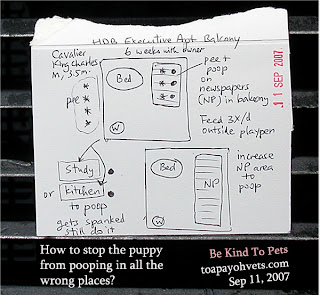 Duration: 6 weeks with the
owner. Duration: 6 weeks with the
owner.
Purchase from pet shop at
Thomson Road. Slatted flooring.
FIRST 7 DAYS AND NIGHTS
1. Strict confinement in the
playpen. "Hardly comes out of the playpen," the
lady said. "She comes out 1 hour to play. I
watched for signs of elimination and put into
playpen. Not allowed to come out of the playpen
till she has pooped. By day 7, the puppy is
paper-trained."
But after 7 days, the puppy is let out. She
follows the lady owner everywhere. Needs human
company all the time.
2. Whining for first night.
Ignored. Puppy slept without much trouble in the
playpen.
3. At night, still sleep in the playpen as she
is not paper-trained.
FROM WEEK 1 TO WEEK 6 (PRESENT)
Main problems are pooping in the kitchen and
study room (morning) up to now. "Thorough
cleaning with Dettol has no effect," the lady
said. In the evening, will poop on the
newspapers in the balcony.
Feeding 3x/day. Breakfast, lunch sometimes and
dinner. Dry food with some puppy milk. Feed bowl
inside playpen. 3 tablespoons dry food per meal.
Chew bones are dried chicken jerky not the soft
meat balls which cause diarrhoea. Milk does not
cause diarrhoea in this puppy.
Poop 3-4 X. Overnight, after
breakfast at 7 am, lunch time (irregular) and
after dinner. He poops 30 - 60 minutes later,
not shortly after meals. After lunch, poops on
balcony newspapers (new ones) or kitchen and the
study. After dinner, poops on the newspapers in
the balcony (new ones). Sleeps at 11 p.m.
Pees- many times. Papers are changed "hourly".
WHAT ARE THE SOLUTIONS?
1. In my opinion, the puppy just wants a clean
place to poop or pee. Why did she poop in the
study room despite "spanking"?
The one full page of the Straits Times would be
soiled overnight. The daughter would take the
puppy out of the playpen after breakfast,
assuming she had had pooped. The poo was
overnight. The puppy would rush to the clean
same spot in the study or kitchen to poop!
What's the solution?
1. Overnight, the playpen newspapers are soiled.
There is a need for a 2nd
toilet location for the puppy as she is growing
up. A newspaper on the pee pan in the kitchen
bathroom would be ideal.
"Shut the study room. The puppy would go to the
kitchen," the lady said. "The puppy likes to pee
outside the playpen in the same
area."
2. Increase the newspaper coverage inside the
playpen from 25% to 50%.
3. Neutralise urine smell with vinegar:water
1:3. Stool smells are not neutralised similarly.
4. Wakes up, change soiled newspapers. Daughter
feeds her and let her out. This is where the
puppy seeks the study or balcony to poop if
unsupervised for 1 minute!
CONCLUSION
Puppy is 50% paper-trained in the sense that she
pees on newspapers in the balcony. However, she
does poop on newspapers too but not all the
time. Sometimes inside the forbidden areas in
the study and the kitchen.
The best solution may be a 2nd toilet location -
a pee pan with newspapers in the kitchen
bathroom area. Increase the paper area as the
puppy is growing bigger and eliminates more. She
wants to be clean.
No distractions after feeding but it seems this
is not possible with 2 kids around. So the puppy
poops much later after the excitement of playing
with the kids. Feed 2x/day to regulate the bowel
movement so that pooping is reduced to 2x/day
after food.
The owner supervises the kids. She is very
strict with the kids playing rough with the
puppy. The 5-year-old used to pull the puppy's
tail or ears and was taught not to do it. The
kids are discouraged from encouraging the puppy
to bite and jump, or giving table food or hand
feeding. She did not take leave to go overseas
so that the puppy can be properly trained.
COMMENTS
It seems to me that the puppy would be
successfully paper-trained in 14 -28 days if she
has had provided a 2nd toilet
location esp. after the puppy wakes up and as
she changes the newspapers. Open the playpen and
let the puppy run to the 2nd toilet location.
SOME OF MY INTERESTING PUPPY RECORDS
1.
Overview of puppy toilet training in Singapore
2.
Dr Sing's Chihuahua Caesarean sections in 2003
3.
A home-breeder's overdue Chihuahua
4. Dr
Sing's Chihuahua Caesarean sections in 2003
5.
Dr Sing's Chihuahua Caesarean sections in 2003
6.
Dr Sing's Caesarean pictures in 2004
7.
How to paper-train your puppy
8.
Toxic Chihuahua
9.
Elective Caesarean sections for Chihuahuas
10.
Chihuahua Caesareans in 2004
11.
Dr Sing's Caesarean sections in 2004
12.
Export sales of Singapore puppies
13.
A Bull Terrier Caesarean section
14.
A Jack Russell Caesarean Section
15.
Herniated large intestines in a Chihuahua puppy
16.
56th day Caesarean Section of a Chihuahua
17.
Distemper and parvoviral outbreaks in a breeding kennel
18.
2003 pictures of puppies and dogs
19.
2004 pictures of puppies and dogs
20.
2003 pictures of puppies
21.
Daddy's Beagle surprise for the PSLE girl
22.
2004 pictures of puppies
23.
Rigor mortis in a puppy
24.
Puppy abuse in Singapore
25.
2003 cases
26.
Last-minute Caesarean section
|
|
Advertisement |
|
|
|
More
info at:
Urinary Tract Infections and Stones in the dog in Singapore.
To make an appointment:
e-mail
judy@toapayohvets.com
tel: +65 9668-6469, 6254-3326 |
 toapayohvets.com toapayohvets.com
Be Kind To Pets
Veterinary Education
Project 2010-0129 |
|
|
 Duration: 6 weeks with the
owner.
Duration: 6 weeks with the
owner.  TOA
PAYOH VETS
TOA
PAYOH VETS